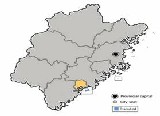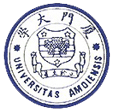Xiamen City Facts & Districts Guide
Located at the southeast coast of China, Xiamen is a tourist
city of Fujian province famous for its attractive seascape.
Xiamen is a city which combines harmoniously material prosperity,
cultural diversity, and political progress.Xiamen is the second
largest city in Fujian province next to the capital city of Fuzhou,
is smaller and prettier than Fuzhou. It offers a lot more to
see, its streets and buildings, attractive shopping arcades and
bustling seafront boasting a nineteenth-century European flavor.
In March 2005, it was ranked 9th among 200 Chinese cities for
its comprehensive strength.
Xiamen City Facts
Xiamen District Guides
Map of Xiamen
Administration Type |
Sub-Provincial City |
Population |
1,532,200 |
Land Area |
4114 square kilometers (604
square miles) |
Zip Code |
361000 |
Area Code |
0592 |
Time Zone |
GMT / UTC +8 |
Nationalities |
The Han people form the majority,
with the rest made up of more than 20 ethnic groups, including
the Hui, Manchu, Zhuang, She, Miao, and Gaoshan |
Language |
Mandarin |
Religions |
Buddhism, Christianity-both
Catholic and Protestant, and Islam are the main religions.
Xiamen has a number of religious organizations, including
the Buddhist Association, the Catholic Administrative Committee,
the Islamic Association, and Chinese Christian Church. Nanputuo
Temple, quite a few Protestant churches around Xiamen with
history dates back to 1840, the Xinjie church, located at
the intersection of Siming Road and Zhongshan Road, was
the first protest church in China, the Catholic Church on
Gulangyu Islet are all popular places for religious activities. |
City Nickname |
Egret Island |
City Tree |
Flame Tree |
City Flower |
Bougainvillea |
City Bird |
Egret |
Electricity |
220V, 50Hz; plugs can be three-pronged
angled, three-pronged round, two flat pins or two narrow
round pins |
Awards |
"The Habitat Scroll of Honour
Award", "International Garden City", "National Excellent
City for Tourism", "National Model City for Environmental
Protection", "National Sanitary City", "National
Garden City". |
Xiamen comprises six different districts, including neighboring
Gulangyu Island.
 Xiamen
comprises Xiamen Island, Gulangyu Island, and a larger region
along the mouth of Jiulong River on the continent.Huli District
and most of Siming District (except Gulangyu) are on Xiamen Island,
while the other four districts lie on the mainland. The districts
of Siming and Huli form the Special Economic Zone.In May 2003,
Gulangyu Island and Kaiyu an District were merged into Siming
District, Xinglin District was merged into Jimei District, and
Xiang'an District was created out of a section of Tong'an District. Xiamen
comprises Xiamen Island, Gulangyu Island, and a larger region
along the mouth of Jiulong River on the continent.Huli District
and most of Siming District (except Gulangyu) are on Xiamen Island,
while the other four districts lie on the mainland. The districts
of Siming and Huli form the Special Economic Zone.In May 2003,
Gulangyu Island and Kaiyu an District were merged into Siming
District, Xinglin District was merged into Jimei District, and
Xiang'an District was created out of a section of Tong'an District.
Kaiyuan District
Kaiyuan District, better known as downtown, has streets pulsing
with humanity.Yet, somehow, the Xiamen magic shines through and
instead of feeling annoyingly busy, it instead comes across as
excitingly vibrant.The lodging options are many and include the
Best Western and the wildly plush Marco Polo, which rests along
the lapping shores of Yuandang Lake.Its Lotus Court Restaurant
is locally revered for both its cuisine and its calming views of
the lake.Nightlife also abounds, and the oddly named KK Recreation
Ground offers prime time dancing.
Xinglin District
Located northwest of downtown on the mainland, the Xinglin District
takes great pride in being the birthplace of Xiamen industry.Electronics,
machinery, chemicals and textiles are the pillars of this district's
economic scene.
Haicang District
Haicang was always the port of call for trade incoming to Xiamen.In May of 1989, Chinese central government established the Haicang
Disrict as investment area for Taiwan businessman.Since then,
Haicang has developed world class port, industrial and agricultural
base for exports.The government of Haicang Investment Zone actively
invites foreign investment in high technology and capital intense
industries, with emphasis on electronics, manufacturing, petrochemicals,
machinery, refined chemicals, new building materials, biotechnology
and pharmaceuticals industry.
Huli District
Located north of downtown, Huli District houses one of Xiamen's
best five-star hotels иCYuehua Hotel.Since the addition of the
Gaoqi International Airport in 1996, developers have migrated in,
making it into one of the area's largest business centers.
Jimei District
The Jimei District is another tourist jewel for it represents the
first mainland stop after exiting Xiamen via the causeway.The
scenic village of Jinmen,
highlighted by the world famous Jimei School Village, is a must
visit with all tour companies.And nearby Yuewain Mountain rates
as an easily accessible city escape full of hiking trails, ancient
relics and lush green forests.
Siming District
Situated to the east of downtown, Siming District serves as Xiamen's organic
side.The Xiamen beach area makes endless summers a possibility, while the bordering
mountains lend for plenty of hiking options.Xiamen University is here, its
beautiful setting making it one of the most scenic campuses in the world.
Tong'an District
This mainland district of almost 550,000 people challenges Xiamen's "Garden
of the Sea" label.Known mainly for its industry, with a
heavy lean on technology, the Tong'an Distrcit is vastly important
within the business sector.
Xiang'an District
Xiang'an District is a district of Xiamen on its eastern most
mainland territory.It was created out of five towns of Tong'an
District in May 2003, including Xindian, Xinyu, Maxiang, Neicuo
and Dadeng.Xiamen is constructing the Xiamen Xiang'an Tunnel
which is about 9 kilometers long.This includes 5.95 kilometres
of the tunnel under water.It starts from Wutong of Xiamen Island
and terminates at Xibin, Xiang'an District.It is scheduled to
be completed by 2009.
Gulangyu Island
Gulangyu Island, tiny in size, is a huge attraction and reigns
as the superstar of Xiamen's tourism industry.Accessible only
by ferry, its winding cobblestone streets wander past endless rows
of old colonial buildings canopied by lush green trees, creating
the kind of idealistic setting that even the folks at Disney cannot
recreate.A ban on cars heightens its impossible charm, making
the pedestrian king of the streets.Sunlight Rock, Zheng Chenggong
Memorial Hall, the intoxicatingly scenic Shuzhuang Garden and the
Xiamen Museum are just a few of its many attractions.The island
also enjoys national recognition for its devotion to music, and
proof of this can be heard at the pragmatically named Music Hall
of Gulang Island.Lodging options are limited, but the Gulangyu
Guesthouse rates as a tourist favorite.

|

 Xiamen
comprises Xiamen Island, Gulangyu Island, and a larger region
along the mouth of Jiulong River on the continent.Huli District
and most of Siming District (except Gulangyu) are on Xiamen Island,
while the other four districts lie on the mainland. The districts
of Siming and Huli form the Special Economic Zone.In May 2003,
Gulangyu Island and Kaiyu an District were merged into Siming
District, Xinglin District was merged into Jimei District, and
Xiang'an District was created out of a section of Tong'an District.
Xiamen
comprises Xiamen Island, Gulangyu Island, and a larger region
along the mouth of Jiulong River on the continent.Huli District
and most of Siming District (except Gulangyu) are on Xiamen Island,
while the other four districts lie on the mainland. The districts
of Siming and Huli form the Special Economic Zone.In May 2003,
Gulangyu Island and Kaiyu an District were merged into Siming
District, Xinglin District was merged into Jimei District, and
Xiang'an District was created out of a section of Tong'an District.
